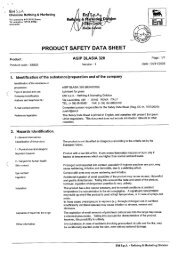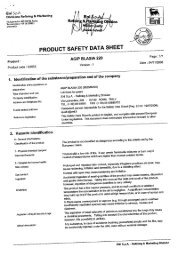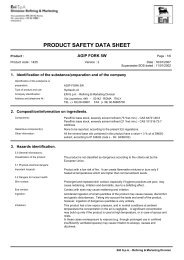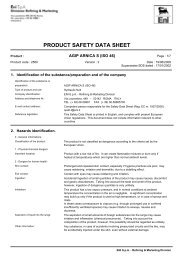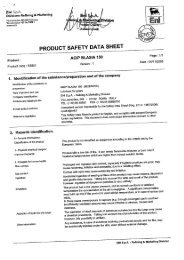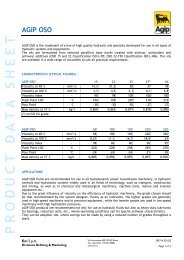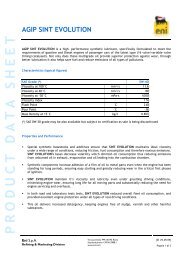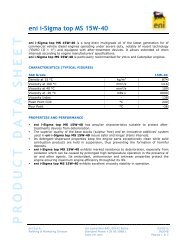eni blasia ml (iso vg 320) ghs sds 32-2950 - TransDiesel
eni blasia ml (iso vg 320) ghs sds 32-2950 - TransDiesel
eni blasia ml (iso vg 320) ghs sds 32-2950 - TransDiesel
You also want an ePaper? Increase the reach of your titles
YUMPU automatically turns print PDFs into web optimized ePapers that Google loves.
ENI BLASIA ML (ISO VG <strong><strong>32</strong>0</strong>)<br />
Chemwatch GHS Safety Data Sheet<br />
Issue Date: 31-Jul-2012 CHEMWATCH <strong>32</strong>-<strong>2950</strong><br />
C868SP<br />
Version No:3.1.1.1<br />
CD 2012/3 Page 5 of 6<br />
Section 11 - TOXICOLOGICAL INFORMATION<br />
SKIN<br />
■ The liquid may be miscible with fats or oils and may degrease the skin, producing a skin reaction described as non-allergic<br />
contact dermatitis.<br />
The material is unlikely to produce an irritant dermatitis as described in EC Directives .<br />
■ Open cuts, abraded or irritated skin should not be exposed to this material.<br />
■ The material may accentuate any pre-existing dermatitis condition.<br />
■ Entry into the blood-stream, through, for example, cuts, abrasions or lesions, may produce systemic injury with harmful effects.<br />
Examine the skin prior to the use of the material and ensure that any external damage is suitably protected.<br />
INHALED<br />
■ The material is not thought to produce adverse health effects or irritation of the respiratory tract (as classified by EC<br />
Directives using animal models).<br />
Nevertheless, good hygiene practice requires that exposure be kept to a minimum and that suitable control measures be used in an<br />
occupational setting.<br />
■ Inhalation hazard is increased at higher temperatures.<br />
■ Not normally a hazard due to non-volatile nature of product.<br />
■ Inhalation of oil droplets or aerosols may cause discomfort and may produce chemical inflammation of the lungs.<br />
CHRONIC HEALTH EFFECTS<br />
■ Substance accumulation, in the human body, may occur and may cause some concern following repeated or long-term occupational<br />
exposure.<br />
Oil may contact the skin or be inhaled. Extended exposure can lead to eczema, inflammation of hair follicles, pigmentation of the<br />
face and warts on the soles of the feet. Exposure to oil mists can cause asthma, pneumonia and scarring of the lungs. Oils have<br />
been linked to cancer of the skin and scrotum. Compounds that are less viscous and with smaller molecular weights are more<br />
dangerous. There may be liver damage and the lymph nodes may be affected; heart inflammation can also occur at high doses.<br />
TOXICITY AND IRRITATION<br />
■ Not available. Refer to individual constituents.<br />
Section 12 - ECOLOGICAL INFORMATION<br />
No data<br />
Ecotoxicity<br />
Ingredient Persistence: Persistence: Air Bioaccumulation Mobility<br />
Water/Soil<br />
mineral oil No Data No Data No Data No Data<br />
Available Available Available Available<br />
Section 13 - DISPOSAL CONSIDERATIONS<br />
■ Legislation addressing waste disposal requirements may differ by country, state and/ or territory. Each user must refer to<br />
laws operating in their area.<br />
A Hierarchy of Controls seems to be common - the user should investigate:<br />
• Reduction.<br />
• DO NOT allow wash water from cleaning or process equipment to enter drains.<br />
• It may be necessary to collect all wash water for treatment before disposal.<br />
• In all cases disposal to sewer may be subject to local laws and regulations and these should be considered first.<br />
• Where in doubt contact the responsible authority.<br />
• Recycle wherever possible or consult manufacturer for recycling options.<br />
• Consult State Land Waste Authority for disposal.<br />
• Bury or incinerate residue at an approved site.<br />
• Recycle containers if possible, or dispose of in an authorised landfill.<br />
Section 14 - TRANSPORTATION INFORMATION<br />
NOT REGULATED FOR TRANSPORT OF DANGEROUS GOODS: UN, IATA, IMDG<br />
continued...







